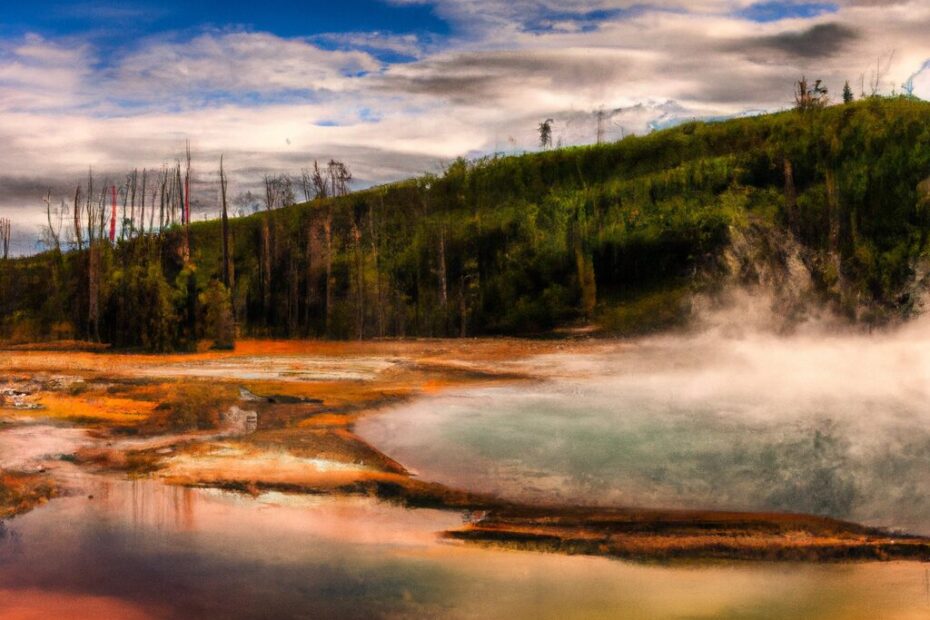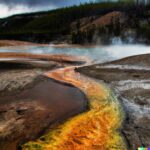Yellowstone National Park is famous for its stunning geysers, but did you know that these natural wonders are being impacted by climate change?
In this article, we will explore the connection between Yellowstone geysers and climate change. We will discuss how geysers work and how they are influenced by changes in temperature and precipitation. We will also examine the observed impacts of climate change on the eruption patterns, size, shape, and bacterial community of geysers.
We will look at the potential future impacts of climate change on these iconic natural features and the ecosystem as a whole. Join us as we uncover the fascinating relationship between Yellowstone geysers and climate change.
What Are Yellowstone Geysers?
Yellowstone geysers are natural hydrothermal features found in Yellowstone National Park, renowned for their spectacular eruptions fueled by the park’s geothermal activity and volcanic history.
These geysers are renowned for their distinctive eruptions of scalding water and steam, projecting water jets high into the air.
The geothermal activity that fuels these geysers is a result of the volcanic eruptions that occurred in the park over millions of years. The unique combination of heat, water, and geological formations creates an environment where these thermal features can thrive, making them an essential part of the park’s natural heritage and a significant draw for visitors from across the globe.
How Do Geysers Work?
The operation of geysers is intricately linked to the geothermal activity and hydrothermal system present in Yellowstone, where a reliable heat source triggers the periodic eruptions of superheated water and steam.
What Is The Connection Between Yellowstone Geysers And Climate Change?
The relationship between Yellowstone geysers and climate change encompasses the potential environmental impact of global warming on the park’s thermal features and the broader ecosystem.
This interplay has drawn attention to the vulnerability of thermal features, as heightened temperatures and altered precipitation patterns could disrupt the delicate balance of geothermal systems.
As the Earth’s climate continues to warm, the frequency and distribution of geyser eruptions may shift, impacting not only the iconic geysers but also the surrounding flora and fauna. Changes in water availability and quality could pose significant challenges for the diverse wildlife that depend on these resources.
Understanding and mitigating these impacts is crucial for preserving the unique ecological dynamics of the Yellowstone ecosystem.
What Is The Impact Of Climate Change On Geysers?
The impact of climate change on Yellowstone geysers encompasses potential environmental consequences such as ecosystem disruption and alterations in the geyser eruption patterns.
The geysers, renowned for their breathtaking beauty and ecological importance, are currently undergoing changes in eruption timing and duration. These shifts are a result of rising temperatures and shifting precipitation patterns. This disturbance not only impacts the geothermal environment but also has consequences for the surrounding ecosystems.
As the eruption patterns of the geysers change, the flora and fauna that depend on this distinctive habitat for survival face unprecedented challenges. This could potentially lead to species displacement and a loss of biodiversity.
How Are Geysers Affected By Changes In Temperature And Precipitation?
Changes in temperature and precipitation patterns can significantly influence the behavior of Yellowstone geysers, necessitating thorough environmental monitoring to understand their impact.
This monitoring is crucial for predicting how changing climate conditions will alter the eruption frequency and duration of geysers, as well as the overall hydrothermal system dynamics.
By closely tracking these environmental variables, researchers and park management can gain insights into the response of geysers to climate change. This data can inform conservation efforts and help ensure the preservation of these natural wonders for future generations.
What Is The Role Of Groundwater In Geysers And Climate Change?
Groundwater plays a pivotal role in the functioning of geysers, impacting the hydrothermal system and contributing to the intricate water chemistry influenced by the effects of climate change.
Groundwater plays a crucial role in the functioning of geysers, serving as their main source of water and affecting their eruptions and thermal processes. The combination of groundwater and heat from the Earth’s interior results in the build-up of pressure, leading to the impressive displays of steam and hot water that define geysers.
The composition of groundwater, including its mineral content and temperature, has a significant impact on the distinctive water chemistry of geysers. This makes them ideal locations for studying the effects of environmental changes on hydrothermal systems.
How Have Yellowstone Geysers Been Affected By Climate Change?
The effects of climate change have manifested in discernible changes within Yellowstone geysers, prompting ongoing scientific research and the implementation of environmental policies to address their preservation.
This has led scientists to closely monitor the geysers’ behavior. Rising temperatures and altered precipitation patterns can impact their delicate balance.
Geological processes, such as hydrothermal activity and subsurface water flow, play a significant role in understanding these changes. Collaborative efforts between environmental agencies and researchers are crucial in formulating effective policies to mitigate the impact of climate change on these natural wonders.
What Changes Have Been Observed In The Eruption Patterns Of Geysers?
Observations have revealed notable changes in the eruption patterns of Yellowstone geysers, prompting extensive scientific research and environmental monitoring to understand and mitigate these alterations.
Recent changes in geyser activity have prompted an increase in scientific research to understand the underlying causes and potential effects on the surrounding ecosystem.
Advanced monitoring equipment has been deployed to track the frequency, duration, and intensity of geyser eruptions, providing crucial data for identifying deviations from historical patterns and analyzing associated environmental changes. By combining this information with geological surveys and climate data, scientists hope to unravel the complexities of geyser behavior and its interconnectedness with broader environmental dynamics.
Have There Been Any Changes In The Size Or Shape Of Geysers?
Shifts in the size and shape of Yellowstone geysers have been subjects of interest, prompting geological processes studies and land management initiatives to safeguard these natural features.
Researchers have been analyzing the potential impacts of seismic activities and hydrothermal disturbances on the morphology of geysers within the Yellowstone National Park. Through collaborative efforts, conservationists and geologists are striving to develop proactive measures capable of preserving the unique geological formations and the biodiversity they support.
These initiatives include the implementation of sustainable tourism practices and the establishment of exclusion zones to minimize human impact on these delicate ecosystems, ensuring the longevity of these magnificent natural wonders for future generations.
How Has The Bacterial Community In Geysers Changed Due To Climate Change?
The bacterial community within Yellowstone geysers has undergone transformations due to climate change. This has prompted the adoption of sustainable practices to mitigate the environmental impact on this crucial ecosystem component.
This shift in the bacterial community has raised concerns about the ecological balance within the geysers. Researchers have observed fluctuations in microbial diversity and activity, which could have far-reaching consequences for the overall ecosystem health. It is imperative to establish sustainable strategies to preserve the delicate equilibrium of these geothermal environments and ensure their continued resilience in the face of climate change. By understanding the shifts in bacterial communities and their implications, conservation efforts can be tailored to effectively protect these unique habitats.
What Are The Potential Future Impacts Of Climate Change On Yellowstone Geysers?
Anticipating the potential future impacts of climate change on Yellowstone geysers involves considerations of atmospheric changes and the sustainable utilization of geothermal energy resources to preserve these natural wonders.
Climate change is causing shifts in global weather patterns, which could disrupt the delicate balance of underground heat sources that power geysers. This could have consequences for the frequency and intensity of geysers. It is important for stakeholders to develop sustainable management strategies for geothermal energy resources, taking into account the preservation of natural processes that maintain these geysers.
To ensure the long-term preservation of this unique geological phenomenon, it is crucial to understand the implications of atmospheric changes on the geothermal systems in Yellowstone National Park. This will allow for effective management and conservation efforts to be implemented.
How Might Increased Temperatures Affect Geysers In The Future?
The potential impact of increased temperatures on Yellowstone geysers in the future necessitates comprehensive geological processes studies and ongoing environmental monitoring to anticipate and address any alterations.
Studying geysers can reveal insights into their behavior and response to temperature changes. It’s important to continuously monitor the environment to detect any significant alterations in geyser activity. This allows for timely intervention and conservation efforts.
By using advanced research methods and technology, scientists and environmental experts can better understand the dynamic relationship between temperature variations and geyser behavior. This enables informed decision-making for the preservation of these natural wonders.
What Could Happen To Geysers If Precipitation Patterns Continue To Shift?
Continued shifts in precipitation patterns could impact the water temperature of geysers in Yellowstone, necessitating conservation efforts to mitigate potential disruptions to their natural processes.
These changes in precipitation could lead to alterations in the water supply to the geysers, affecting their natural thermal dynamics. If this happens, it may disrupt the delicate balance of heat and pressure that allows geysers to function.
Conserving water resources in the surrounding areas can help maintain the consistent water supply necessary for the geysers to sustain their unique thermal activities. Without proactive conservation measures, the potential consequences of shifting precipitation patterns on geyser water temperature could significantly impact the ecological equilibrium of these natural wonders.
What Are The Possible Consequences For The Ecosystem If Geysers Are Affected By Climate Change?
The potential impact of climate change on Yellowstone geysers carries implications for the broader ecosystem, necessitating the implementation of environmental policies to safeguard biodiversity and ecological balance.
Geysers are essential for maintaining the delicate balance of ecosystems due to their unique hydrothermal features. Any impact on these geysers from climate change could disrupt the habitat and migration patterns of various plant and animal species, causing a ripple effect throughout the entire ecosystem.
It is crucial to prioritize the protection of geysers through the development and enforcement of environmental policies. This is necessary for biodiversity conservation and maintaining ecological stability.
Frequently Asked Questions
How are Yellowstone geysers affected by climate change?
Climate change is causing changes in the hydrothermal system that powers Yellowstone’s geysers. As temperatures rise, the water cycle that fuels the geysers is being disrupted, resulting in decreased eruption frequency and changes in geyser behavior.
Are the geysers in Yellowstone at risk of extinction due to climate change?
While there is concern about the future of Yellowstone’s geysers, there is currently no evidence that they will become extinct. However, continued monitoring and research is needed to better understand the impact of climate change on these unique natural features.
How does climate change affect the overall ecosystem of Yellowstone National Park?
Climate change is causing a range of impacts on the ecosystem of Yellowstone National Park, including changes in temperature and precipitation patterns, shifts in plant and animal populations, and increased frequency and severity of wildfires.
What steps are being taken to mitigate the effects of climate change on Yellowstone geysers?
The National Park Service, in partnership with other organizations, is actively working to reduce greenhouse gas emissions and promote sustainable practices in order to mitigate the effects of climate change on Yellowstone’s geysers and other natural features.
How can visitors to Yellowstone National Park help to protect the geysers and combat climate change?
Visitors can play a role in protecting the geysers and combatting climate change by following Leave No Trace principles, reducing their own carbon footprint, and supporting sustainable tourism practices. Additionally, learning about and sharing information on the impacts of climate change can help raise awareness and inspire action.
What can we learn from studying the effects of climate change on Yellowstone geysers?
Studying the effects of climate change on Yellowstone’s geysers can provide valuable insights into the impacts of climate change on natural systems and help inform conservation and management efforts. It can also serve as a powerful reminder of the importance of addressing climate change on a global scale.
Last Updated on January 25, 2024 by Jon Waraas – Originally Posted: January 25, 2024

I’m Jon Waraas, and I’ve been navigating the online world since 2006. By day, I’m the proud owner of some eCommerce gems, and by night, I’m the voice behind the adventures on Waraas.Com.
My heart, however, belongs to the wild beauty of Yellowstone National Park. I’ve got a collection of websites dedicated to sharing the wonders of this natural masterpiece. Oh, and did I mention? I’m currently building my own cabin inside the ghost town of Gilmore, Idaho – a cabin with tales to tell!
When I’m not immersed in the digital realm, you’ll find me lacing up my boots for a good hike or setting up camp under the star-studded sky.




